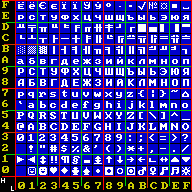Related Research Articles
Indian Standard Code for Information Interchange (ISCII) is a coding scheme for representing various writing systems of India. It encodes the main Indic scripts and a Roman transliteration. The supported scripts are: Bengali–Assamese, Devanagari, Gujarati, Gurmukhi, Kannada, Malayalam, Oriya, Tamil, and Telugu. ISCII does not encode the writing systems of India that are based on Persian, but its writing system switching codes nonetheless provide for Kashmiri, Sindhi, Urdu, Persian, Pashto and Arabic. The Persian-based writing systems were subsequently encoded in the PASCII encoding.
The Kamenický encoding, named for the brothers Jiří and Marian Kamenický, was a code page for personal computers running DOS, very popular in Czechoslovakia around 1985–1995. Another name for this encoding is KEYBCS2, the name of the terminate-and-stay-resident utility which implemented the matching keyboard driver. It was also named KAMENICKY.

Code page 866 is a code page used under DOS and OS/2 in Russia to write Cyrillic script. It is based on the "alternative code page" developed in 1984 in IHNA AS USSR and published in 1986 by a research group at the Academy of Science of the USSR. The code page was widely used during the DOS era because it preserves all of the pseudographic symbols of code page 437 and maintains alphabetic order of Cyrillic letters. Initially this encoding was only available in the Russian version of MS-DOS 4.01 (1990), but with MS-DOS 6.22 it became available in any language version.
Windows-1257 is an 8-bit, single-byte extended ASCII code page used to support the Estonian, Latvian and Lithuanian languages under Microsoft Windows. In Lithuania, it is standardised as LST 1590-3, alongside a modified variant named LST 1590-4.
Mac OS Central European is a character encoding used on Apple Macintosh computers to represent texts in Central European and Southeastern European languages that use the Latin script. This encoding is also known as Code Page 10029. IBM assigns code page/CCSID 1282 to this encoding. This codepage contains diacritical letters that ISO 8859-2 does not have, and vice versa.
Code page 863 is a code page used under DOS in Canada to write French although it lacks the letters Æ, æ, Œ, œ, Ÿ and ÿ.

Code page 737 is a code page used under DOS to write the Greek language. It was much more popular than code page 869 although it lacks the letters ΐ and ΰ.
Code page 869 is a code page used under DOS to write Greek and may also be used to get Greek letters for other uses such as math. It is also called DOS Greek 2. It was designed to include all characters from ISO 8859-7.
Code page 862 is a code page used under DOS in Israel for Hebrew.

The ZX Spectrum character set is the variant of ASCII used in the ZX Spectrum family computers. It is based on ASCII-1967 but the characters ^, ` and DEL are replaced with ↑, £ and ©. It also differs in its use of the C0 control codes other than the common BS and CR, and it makes use of the 128 high-bit characters beyond the ASCII range. The ZX Spectrum's main set of printable characters and system font are also used by the Jupiter Ace computer.
Mac OS Ukrainian is a character encoding used on Apple Macintosh computers prior to Mac OS 9 to represent texts in Cyrillic script which include the letters ‹Ґ› and ‹ґ›, including the Ukrainian alphabet.
Computer Braille is an adaptation of braille for precise representation of computer-related materials such as programs, program lines, computer commands, and filenames. Unlike standard 6-dot braille scripts, but like Gardner–Salinas braille codes, this may employ the extended 8-dot braille patterns.
Code page 912 is a code page used under IBM AIX and DOS to write the Albanian, Bosnian, Croatian, Czech, English, German, Hungarian, Polish, Romanian, Serbian, Slovak, and Slovene languages. It is an extension of ISO/IEC 8859-2, though prior to 1999, the code page matched ISO/IEC 8859-2 exactly.
Code page 915 is a code page used under IBM AIX and DOS to write the Bulgarian, Belarusian, Russian, Serbian and Macedonian but was never widely used. It would also have been usable for Ukrainian in the Soviet Union from 1933 to 1990, but it is missing the Ukrainian letter ge, ґ, which is required in Ukrainian orthography before and since, and during that period outside Soviet Ukraine. As a result, IBM created Code page 1124. It is an extension of ISO/IEC 8859-5. The original code page matched ISO/IEC 8859-5 directly.
Code page 1118 is a code page used under DOS to write the Lithuanian language. It was previously standardised in Lithuania as LST 1283.
Code page 1117 is a code page used under DOS to write the Estonian, Lithuanian and Latvian languages. It is closely related to both code page 773 and code page 775.
Mac OS Croatian is a character encoding used on Apple Macintosh computers to represent Gaj's Latin alphabet. It is a derivative of Mac OS Roman. The three digraphs, Dž, Lj, and Nj, are not encoded.
The PostScript Standard Encoding is one of the character sets used by Adobe Systems' PostScript (PS) since 1984. In 1995, IBM assigned code page 1276 to this character set. NeXT based the character set for its NeXTSTEP and OPENSTEP operating systems on this one.
Code page 921 is a code page used under IBM AIX and DOS to write the Estonian, Latvian, and Lithuanian languages. It is an extension of ISO/IEC 8859-13. The original code page matched ISO/IEC 8859-13 directly.
LST 1590-4 is a character encoding used to write the Lithuanian language. It is a modification of Windows-1257 to support additional accented letters and phonetic notation. This is called Code page 58601 by FreeDOS.
References
- ↑ "Code table from Lithuanian Standard LST 1564:2000 Information technology – 8-bit single-byte character coding – Lithuanian accented letters" (PDF). DKUUG Standardizing. Retrieved 2020-08-24.